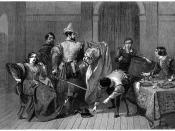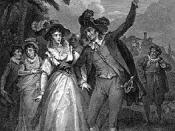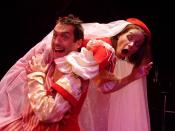Gender issues are explored in both Shakespeare's The Taming of the Shrew and the Zeffirelli film adaptation of the play through cultural context, characterisation, symbolism and the specific portrayal of Katherina and Petruchio's relationship, and are adjusted to meet the needs of very different audiences.
Firstly, the cultural context of each text is vital to their portrayal of gender issues in the play. Both versions of the play were pitched as comedies. Shakespeare wrote the play, his first comedy, in the late 16th Century, and the attitudes and morals towards gender represented in the play are very much a reflection of the time period. So although "a feminist argument is not explicit" (Sexism & the Battle of the Sexes in The Taming of the Shrew, Linda Bamber) in the play, it is a product of a society where arranged marriages were the norm, women were traded and bartered like a comedy ("'Twas a commodity lay fretting by you; 'Twill bring you gain, or perish on the seas."
Tranio, Act 2, Scene 1), women had no right to vote and did not work. Indeed, Kate and Petruchio's relationship is typically Elizabethan: Kate is Petruchio's property, as he points out in the Act 3, Scene 2:
"I will be master of what is mine own.
She is my goods, my chattels, she is my house.
My household stuff, my field, my barn,
My horse, my ox, my ass, my anything."
Petruchio's words leave no doubt as to his belief in the patriarchal marriage system that existed during Shakespeare's time.
In contrast, Zeffirelli's film adaptation was released in the late 1960s, at the same time as women's liberation movement was sweeping the countries of the First World. It features Elizabeth Taylor as Kate and Richard Burton as Petruchio, an interesting casting choice, given the time period and the couple's very public, troubled, off-screen relationship. As a film adaptation in the context of the 1960s, many alterations were made with consideration for the public and the film format: the Induction, the introductory framework that sets up the play within a play, is omitted, allowing the director to focus more on the gender issues rather than the themes of concealed identity; the secondary love story between Lucentio and Bianca is somewhat compressed, minimising contrast between the warring female characteristics of Kate and her sister; and the longer speeches are pared down. To compensate, he provides more physical action, making the comedy more readily approachable to modern cinema audiences. Interestingly, Kate's dialogue is cut by about a third, allowing her to be vocally overwhelmed by Petruchio.
Secondly, characterisation is used to explore the gender issues, particularly through Kate, who undergoes the most change, but also through Petruchio, Baptista and Bianca.
In both texts, Kate, who is a rather stereotypical character, illustrates the idea that with badness comes ugliness, shrewishness and meanness. When Kate is first introduced to the viewer, she is dressed raggedly and her raven-coloured hair is straggly and messed up. Slowly, she is forced to surrender and for the first time is seen in a more attractive light, for instance in Zeffirelli's invented wedding scene. Shakespeare, in contrast, does not make any reference to Kate's physical appearance.
Bianca provides contrast to her older sister's character, as she exemplifies the ideal Elizabethan woman: young, innocent, beautiful, all the characteristics that are associated with goodness. However, this quiet outside demeanor is exposed in the end as Bianca becomes vocally disobedient. She is also an example of the objectification of women, as represented in Zeffirelli's film version, and the idea of women merely being objects of men's desire, as in Act 1, Scene 1, when Lucentio first lays eyes on her: "Thy beauty casts a spell". Her characterisation is sidelined in Zeffirelli's film, as is her sub-plot romance with Lucentio, whereas in the original play she grows gradually more assertive where Kate grows gradually submissive, providing a further point of contrast in appropriate and inappropriate feminine behaviour.
Petruchio is depicted in both texts as an aggressive, but lovable chauvinist. His intentions are made clear early in the play: "I come to wive it wealthily in Padua; If wealthily, then happily in Padua." To "wive and thrive," he doesn't care what his future wife looks like or acts like. "Why, nothing comes amiss, so money comes withal."
Baptista also represents a typical Elizabethan character: the patriarch, or perhaps the salesman, whose main purpose is to marry off his daughters to wealthy suitors as soon as possible, and has an extremely mercantile approach to matrimony.
Thirdly, the bulk of the exploration of gender issues takes place in the portrayal of Kate and Petruchio's relationship. Although Kate and Petruchio's verbal duels are witty + humourous, and both seem to thrive off them, Kate seems to come out of them worse; she is portrayed as not possessing the intellectual wit as her male counterpart. Shakespeare portrays this by in line 235, when Katherina finally says "let me go" after running out of witty comments; she is unable to compete with Petruchio any longer.
Zeffirelli emphasises the sexual tension between Kate and Petruchio, depicting a passionate, feuding couple, a coming together of two dominating personalities where only one can come out on top. Despite Kate's wicked behaviour, she slowly falls in love with Petruchio, and he upholds her like a prize, he has tamed her pride and her spiky personality. This depiction of Kate also helps to smooth the apparent suddenness with which Kate submits to her husband, and implies that her submission was also an act of love, as well as necessity.
In Zeffirelli's film adaptation, Petruchio is also depicted as privately gentle and genuinely caring to Kate, for instance in Act 4, Scene 1, as she goes to bed at this country house. The scene ends with the quote, "This is a way to kill a wife with kindness". The underlying message here is that Petruchio, by trying to mould his ideal wife and a "household Kate" (Act 2, Scene 1), is indeed acting in Kate's best wishes, an opinion echoed by 19th Century George Bernard Shaw critic in his comment, "It is good for the shrew to encounter a force like that and be brought to her senses". This reinforces traditional Elizabethan attitudes regarding women and their status in relation to men.
Many scholars feel that, despite Kate's submissiveness in the closing scene of the play, she would continue to be a strong opposition for Petruchio. Her representation at the end of the play, however, is very docile and submissive. Kate displays her compliance when she comes at Petruchio's call in the closing scene, which is full of rich symbolism. When one of the men proposed the wager, Petruchio responded by raising the bet significantly. He reasoned that he would wager that much on his hound, but his wife merited a much larger bet. Petruchio displayed complete trust in Kate in that situation, and she came through for him. Many critics have pointed out that the wager scene is dominated by reversals: quiet Bianca talks back finally revealing herself as the true shrew, while Kate reveals herself as an obedient wife. However, Petruchio does not only win the wager, but Kate's speech testifies a generosity worth far more than the two hundred crowns of the wager - she makes an important ideological concession and Petruchio gains control of her. Kate delights in reprimanding the other ladies for their unconventional behaviour, and especially enjoys admonishing Bianca. Likewise, Kate's obedience of her husband's outlandish demands come as somewhat of a surprise after the wager scene. Kate returned with the hat Petruchio had given her, and he instructed her to take off the hat, which Kate actually liked. She once again complied in front of the surprised crowd. As if all of these symbols of her obedience were not enough, Kate shows one more sign. As she concludes the scene and the play, Kate offers to put her hand beneath her husband's foot, an Elizabethan symbol of wifely obedience.
In conclusion, both texts represent gender issues as a consequence of their respective cultural contexts, one representing pre-feminist consciousness and the other representing a period of a blossoming feminist movement, with particular attention paid to characterisation, symbolism and Kate and Petruchio's relationship.


